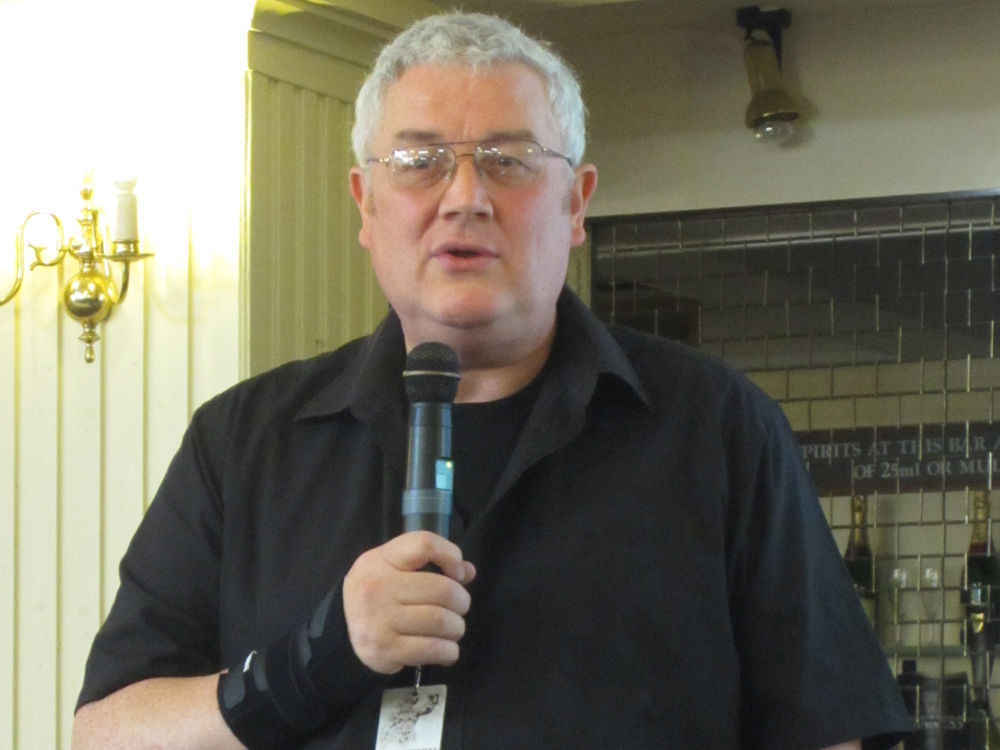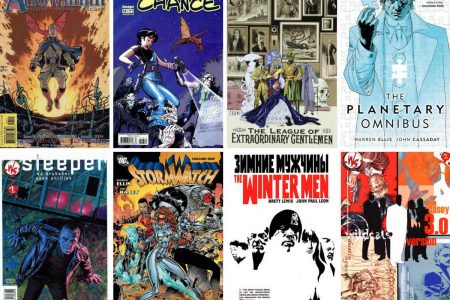The first Northants International Comics Expo (I think the ‘International’ is stretching it, but I guess they wanted the groovy acronym; a bit like the Dublin International Comics Expo wanted ‘D.I.C.E.’) was held in Wicksteed Park, Kettering, on Saturday 22 and Sunday 23 September. I attended on the Saturday because that was the day with the greatest reason to be there – the first convention appearance by Alan Moore in some 20 years. However, I didn’t ignore the rest of the event because also in attendance was my favourite artist, Alan Davis, making it well worth my time and effort.
It was a lovely sunny day (a rarity this summer in the UK) and the expo was held in a lovely location – lots of green spaces and a children’s area and fairground rides and a fishing lake. The first point of order, after obtaining my plastic red bracelet of entry, was to donate two trade paperbacks – entry to Alan Moore’s talk and Q&A required a donation of graphic novel or comic book collection, a nice idea on his behalf. After that, I could wander around the main hall, where the artists were doing signings and sketches. You could tell it was a British comic book convention because this was in a room with a bar. Next was a tour of the marquee where the comic book sellers and independent creators could be found, which was very popular – the convention had attracted a family-orientated crowd, and it was very pleasant to see whole families walking around the stalls.
The first panel was ‘Storytelling – A meeting of mind with Alan Davis’. Alan, sporting a wrist support on his right hand, was showing pencil pages of his work on a projector as demonstrations of the idea of storytelling in comic books, and it was a real masterclass. He really understands what he was talking about – it’s not luck or instinct that has seen him as one of the top artists in the field for 30 years. He really thinks about what he’s doing and the purpose behind his art. He described himself as a ‘dinosaur’ – he likes comics as they were – and he doesn’t think about digital comics at all; he told a story about David Lloyd in the early days of digital comics being so excited with the possibilities, saying how the word panels come up at reading speed and soon would be spoke, to which Alan said, ‘Why? That’s a cartoon.’
Alan talked about the concept of the page, and the left page/right page design, which allows for the reveal on the left page after the right page. He talked about establishing shots allowing you tell the story in detail in panels further down the page; conversely, you can start with a close-up and then pan out. He talked about using a fixed point of view to tell a fight scene allows him to show the fight in a more interesting way. He talked about the difference between using shorthand to tell a story (with knowledge of the material) versus explaining the story in the art so that anyone can read it without prior knowledge. There were pages from Killraven, Excalibur, JLA: The Nail, JLA: Another Nail, Captain Britain, ClanDestine (which he pronounced as ‘clan des-tin’, if you want the official way of saying it), a page from a New Mutants annual that Jim Shooter didn’t like because he thought it was too complicated, even though it was a visually interesting page (it showed five panels around a central television with the screen showing a cartoon Mojo).
Alan talked about each page and the thought that went into each one and why they succeeded via the details and the reference needed (he said that he doesn’t like drawing cars or women shopping, as in a page from Excalibur he showed; also, he doesn’t draw faces straight on because symmetry is impossible and any distortion looks wrong). An interesting topic was the things he needs to do to find solutions to issues in a script, such as doing a page of five panels down a page that was a fixed point of view of the Excalibur team with distraction on the right and the ‘dull’ dialogue (a Chris Claremont Excalibur) and plot on the left – he did say that Claremont is ‘smarter than I am’ and Claremont’s scripts used to be stream of conscience that Alan had to read the dictionary to ‘decode the big words’ and work out what was needed. He said that Mike Barr is a very visual writer who was a good editor and who wrote good scripts on Detective Comics and Batman and the Outsiders.
When Alan finished his presentation, he allowed questions; when asked about Brian Michael Bendis and Avengers Prime in response to ‘talking heads’ comics, he said that Bendis wrote a good script and seemed to trust Alan to do his job on art. He mentioned that he had read bad scripts and told the editors of the problems but they told him to carry on because they would fix it at the end because the digital art can be changed up to the last minute before being sent out, which is unlike the good editors of old, like Archie Goodwin, who would have fixed the problems before the art was started.
Alan talked about the Beholder’s Law, where a good artist can draw things that leave gaps for the reader to see things that aren’t there because it causes them to imagine it. He used Steve Ditko as an example of an artist who could do that, as well as Frank Bellamy (his favourite British artist), who could put the image in your mind with the fewest lines and shapes. Alan is an extremely nice bloke – he very deliberately did not say anything bad about other writers or artists or editor or other comics when talking about the state of modern comics and the way that storytelling in comics doesn’t seem to be as prominent as it used to be, and the fact that he sees scripts where people have been to film school and obviously have written them to take to Hollywood to ask to write a film; but he never named names. The panel could have gone on much longer than the 40 minutes allotted, but it was cruelly kept to time, much to the audience’s chagrin. It was a joy to listen to such a consummate professional who understands his craft and has the ability to explain it.
The second panel of the day was Panel to Screen, talking about adaptations of comic books, with Greg Staples (who did art production on Dredd), Adi Granov (art on the Iron Man films) and Charlie Adlard (artist of The Walking Dead comic book). This was a good-natured chat about the various films and television adaptations, with Granov talking about some of his inside knowledge on the Marvel films, even though he was worried that The Avengers was not going to work after he had done art for it, but was blown away by the final movie. They discussed previous adaptations – there was a lot of hate for Green Lantern – talking about which ones worked and which ones didn’t; this was in their opinion, which is from the point of view of artists, not necessarily as film critics. Granov put it succinctly: if it’s done well, it doesn’t matter.
The third panel, title Erotic Art and Censorship in Comics, was an interesting discussion between comic book journalist/author/curator Paul Gravett, artist Melinda Gebbie and publisher of Knockabout Comics, Tony Bennett. One thing they discussed was the trial in 1990 of a book by Robert Crumb published by Knockabout, a book which they had published to good reviews in the UK several years previously before licensing it to the US and selling out in the UK, and the trial was based on the books they were importing from the US stocks of their own book, which were seized by Customs and Excise (the man who objected was a Seventh Day Adventist) – the whole thing sounded absurd in its logic. The discussion was lively and informed; the most unusual point was the Gebbie thinks that Scalped by Jason Aaron is highly objectionable and that Aaron doesn’t know enough about Native American culture to be writing about it (I don’t think this had anything to do with Aaron’s column about Gebbie’s husband Alan Moore). But we shall talk further about Moore and his panel in the next post.





Great review which I personally appreciate as I was busy looking after the art exhibition at N.I.C.E. Alan popped into have a look at some of the many originals that were on display at the art exhibition and made some really insightful comments there too.
Thanks again
Thank you for your kind words, Norman, and thanks for looking after the art exhibition at N.I.C.E.